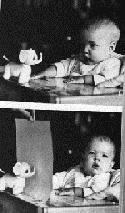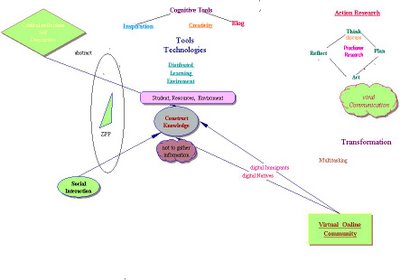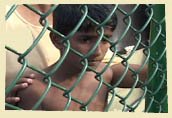Piaget may be best known for his stages of cognitive development. Piaget discovered that children think and reason differently at different periods in their lives. He believed that everyone passed through an invariant sequence of four qualitatively distinct stages. Invariant means that a person cannot skip stages or reorder them. Although every normal child passes through the stages in exactly the same order, there is some variability in the ages at which children attain each stage. The four stages are: sensorimotor - birth to 2 years; preoperational - 2 years to 7 years; concrete operational - 7 years to 11 years; and formal operational (abstract thinking) - 11 years and up. Each stage has major cognitive tasks which must be accomplished. In the sensorimotor stage, the mental structures are mainly concerned with the mastery of concrete objects. The mastery of symbols takes place in the preoperational stage. In the concrete stage, children learn mastery of classes, relations, and numbers and how to reason. The last stage deals with the mastery of thought (Evans, 1973).
...we discovered that education is not something which the teacher does, but that it is a natural process which develops spontaneously in the human being. It is not acquired by listening to words, but in virtue of experiences in which the child acts on his environment. The teacher's task is not to talk, but to prepare and arrange a series of motives for cultural activity in a special environment made for the child. (Dr. Maria Montessori)
JEAN PIAGET'S
THEORY OF DEVELOPMENT
Intelligence
When considering intelligence, Piaget focuses on the mental processes thatoccur, rather than on the actual measure of the intellect. He uses four areasto define intelligence. These areas are: a biological approach to looking at intelligence, the succession of the stages, knowledge, and intellectualcompetence.
Piaget's biological approach, or biological adaption, focuses on thephysical and mental aspects of our bodies. This includes our reflexes whichoccur when certain stimuli trigger an instinctive response. He also discusseshow we adapt to certain situations using assimilation and accomodation. Assimilation occurs when new information is introduced to a person. The personbegins to integrate the new information into existing files, or "schema". Accomodation occurs when the person reorganizes schema to accomodatethemselves with the environment.
The succession of stages involves the movement through four stages thatPiaget has set and defined. Children must move through these stages duringtheir childhood. These include Sensorimotor, Preoperational, Concreteoperational, and Formal operational. Stage movement is an important factor ofPiaget's definition of intelligence, because Piaget states there are a specificset of criteria that must be met and mastered at each stage. In order to movefrom the first stage to the next, the child must master that specific set ofcriteria.
To define Intellectual Competence, Piaget focuses on the highest level offunctioning that can occur at a specific stage. Although Piaget has approximateages assigned to stages, a child's competence is only measured by what stagethey are in, not by age. If the child can only perform tasks that are at thepreoperational stage, that is the highest level the child is at regardless ofage.
SENSORIMOTOR STAGE
The sensorimotor stage is the first of the four stages Piaget uses to definecognitive development. Piaget designated the first two years of an infants lifeas the sensorimotor stage.
During this period, infants are busy discovering relationships betweentheir bodies and the environment. Researchers have discovered that infants haverelatively well developed sensory abilities. The child relies on seeing,touching, sucking, feeling, and using their senses to learn things aboutthemselves and the environment. Piaget calls this the sensorimotor stagebecause the early manifestations of intelligence appear from sensory perceptionsand motor activities.
Through countless informal experiments, infants develop the concept ofseperate selves, that is, the infant realizes that the external world is not anextension of themselves.
Infants realize that an object can be moved by a hand (concept ofcausality), and develop notions of displacement and events. An importantdiscovery during the latter part of the sensorimotor stage is the concept of "objectpermanence".

Object permanence is the awareness that an object continues to existeven when it is not in view. In young infants, when a toy is covered by a pieceof paper, the infant immediately stops and appears to lose interest in the toy(see figure above).This child has not yet mastered the concept of objectpermanence. In older infants, when a toy is covered the child will activelysearch for the object, realizing that the object continues to exist.
After a child has mastered the concept of object permanence, the emergenceof "directed groping" begins to take place. With directedgroping, the child begins to perform motor experiments in order to see what willhappen. During directed groping, a child will vary his movements to observe howthe results will differ. The child learns to use new means to achieve an end. The child discovers he can pull objects toward himself with the aid of a stickor string, or tilt objects to get them through the bars of his playpen.

Concrete Operational Stage
The concrete operational stage is the third stage in Piaget's theory. Thisstage typically occurs between the ages of 7 and 12.
During this stage, the child begins to reason logically, and organizethoughts coherently. However, they can only think about acutal physicalobjects, they cannot handle abstract reasoning.
This stage is also characterized by a loss of egocentric thinking.
During this stage, the child has the ability to master most types of conservationexperiments, and begins to understand reversibility. The concreteoperational stage is also characterized by the child's ability to coordinatetwo dimensions of an object simultaneously, arrange structures in sequence, andtranspose differences between items in a series
THE FORMAL OPERATIONAL STAGE
The formal operational stage is the fourth and final stage in Piaget'stheory. It begins at approximately 11 to 12 years of age, and continuesthroughout adulthood, although Piaget does point out that some people may neverreach this stage of cognitive development.
The formal operational stage is characterized by the ability to formulatehypotheses and systematically test them to arrive at an answer to a problem.
The individual in the formal stage is also able to think abstractly and tounderstand the form or structure of a mathematical problem.
Another characteristic of the individual is their ability to reason contraryto fact. That is, if they are given a statement and asked to use it as thebasis of an argument they are capable of accomplishing the task. For example,they can deal with the statement "what would happen if snow were black".
Stage Movement
According to Piaget, there are four interrelated factors that allow movementfrom stage to stage. These factors include maturation, experience, socialinteraction, and equilibration. Maturation is the physical andpsychological growth that occurs in the child at a specific stage. Experienceis when the child thinks and interacts with real or concrete objects in theexternal environment. Social interaction involves the child socializingwith others, especially chilren. The last factor of stage movement is equilibration,this occurs when the child brings together maturation, experience, and socialinteraction in order to build mental schema. Equilibration is considered to bethe tendency for children to seek cognitive coherence and stability. They aremotivated in this drive for equilibration by disequilibrium or aperceived discrepancy between an existing scheme and something new.
Piagets Conservation Experiments
Conservation is the realization that quantity or amount does not changewhen nothing has been added or taken away from an object or a collection ofobjects, despite changes in form or spatial arrangement (Pulaski, 1980).
Jean Piaget used the idea of conservation in a set of experimentsgeared at studying children's ability to think and reason. Piaget realized thatmaturing children progressively master different types of conservation as theyreason about their world. The cow figure below represents conservation of area.When a child realizes that cows eat the same amount of grass regardless of thespatial location of the grass , they can conserve area.

According to piaget, a student's ability to solve conservation problemsdepends on an understanding of three basic aspects of reasoning: identity,compensation, and reversability.
With mastery of identity: The student realizes that materialremains the same if nothing is added to or subtracted from the material.
With mastery of compensation: The student realizes that changesin one dimension can be offset by changes in another.
With mastery of reversibility: The student realizes that achange may be canceled out by mentally reversing the steps and returning to theorigin.
Cognitive Development









